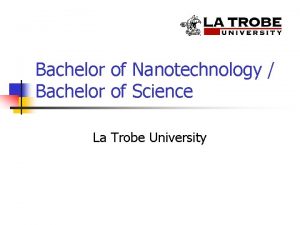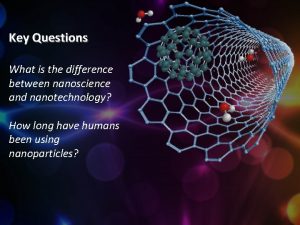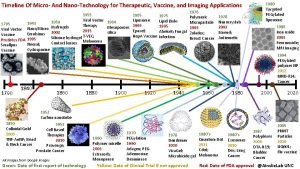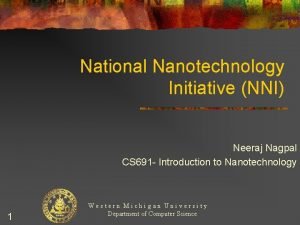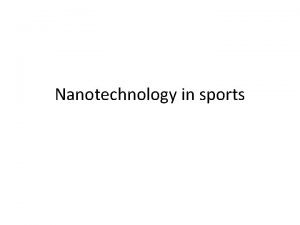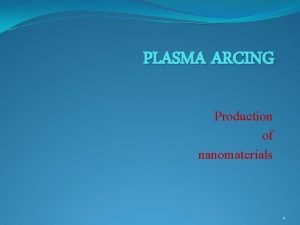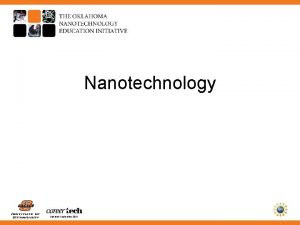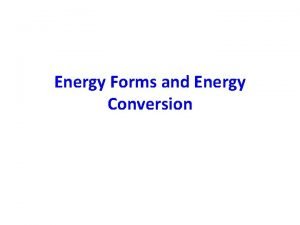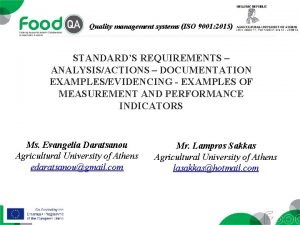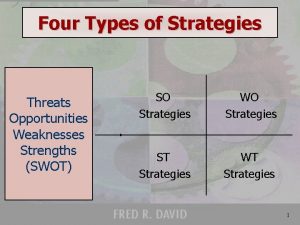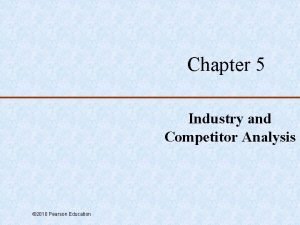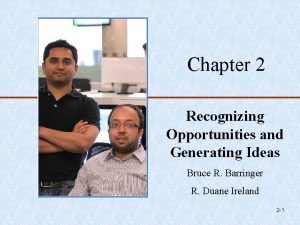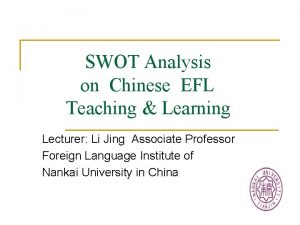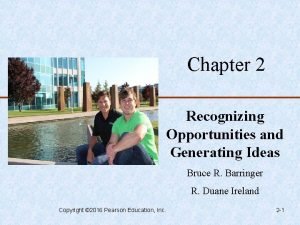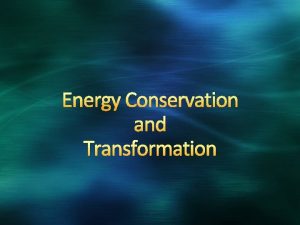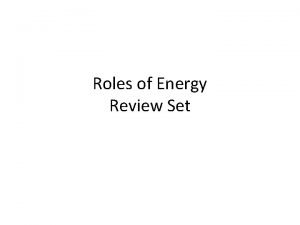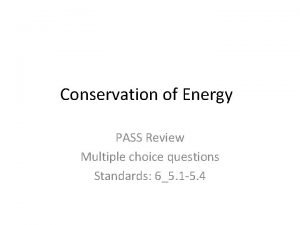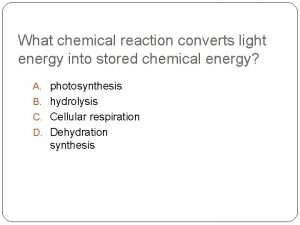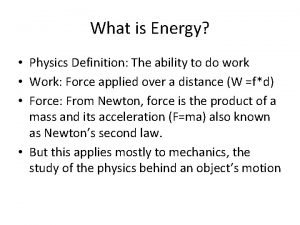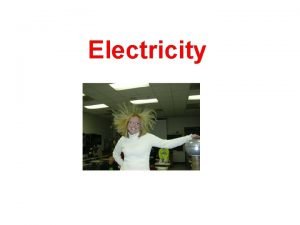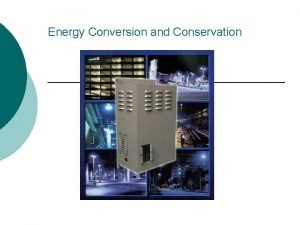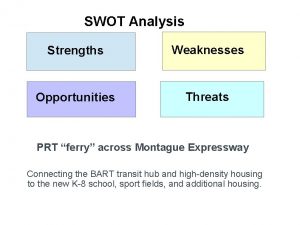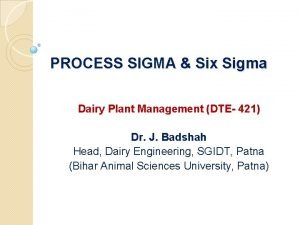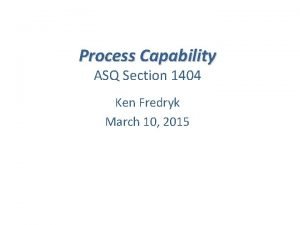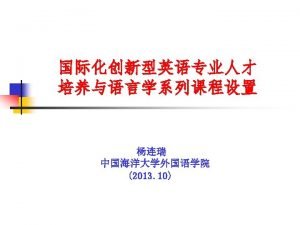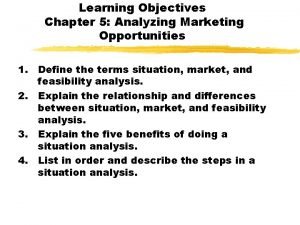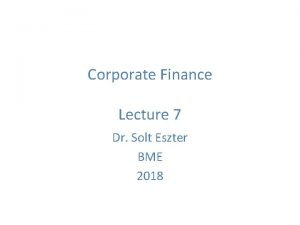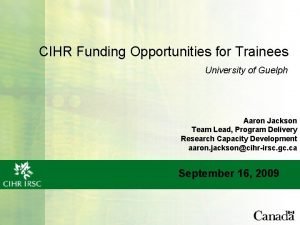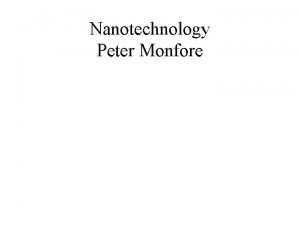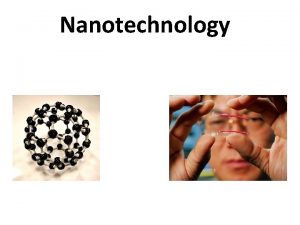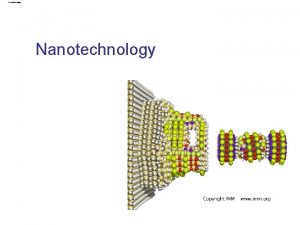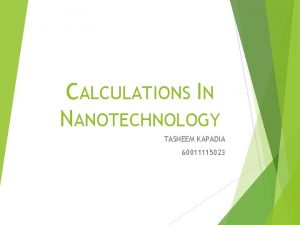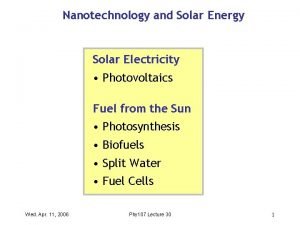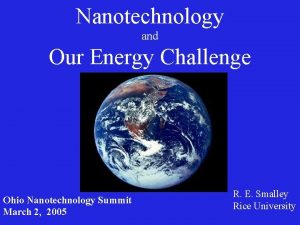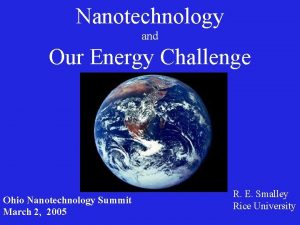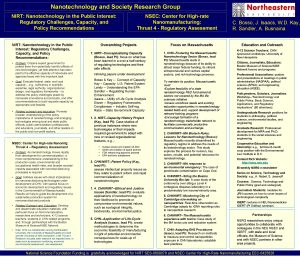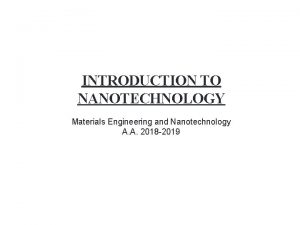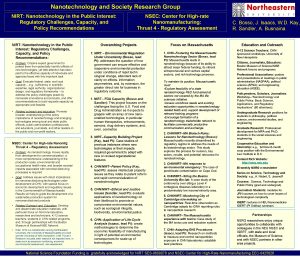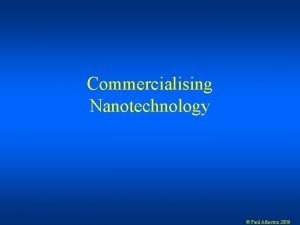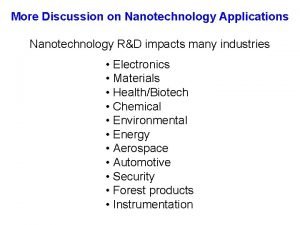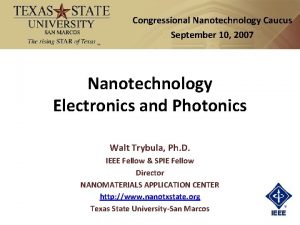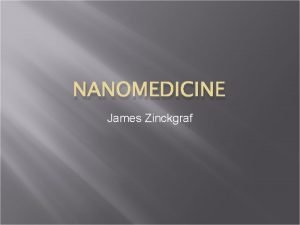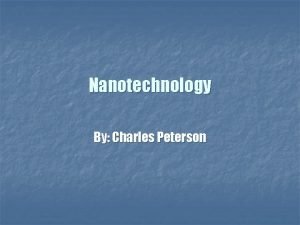Energy and Nanotechnology Issues and Opportunities in Photovoltaics






























































































- Slides: 94

Energy and Nanotechnology Issues and Opportunities in Photovoltaics S. Ismat Shah Physics and Astronomy Materials Science and Engineering Senior Policy Fellow Center for Energy and Environment Policy University of Delaware ICNMRE, Al Maghrib, 2010


Richard Smalley (1943 -2005) Nobel Prize in Chemistry (1996)

Top Ten Global Concerns

Top Ten Global Concerns 1. 2. 3. 4. 5. 6. 7. 8. 9. 10. Population

Top Ten Global Concerns 1. 2. 3. 4. 5. 6. 7. 8. 9. Democracy 10. Population

Top Ten Global Concerns 1. 2. 3. 4. 5. 6. 7. 8. Education 9. Democracy 10. Population

Top Ten Global Concerns 1. 2. 3. 4. 5. 6. 7. Disease 8. Education 9. Democracy 10. Population

Top Ten Global Concerns 1. 2. 3. 4. 5. 6. Terrorism and War 7. Disease 8. Education 9. Democracy 10. Population

Top Ten Global Concerns 1. 2. 3. 4. 5. Poverty 6. Terrorism and War 7. Disease 8. Education 9. Democracy 10. Population

Top Ten Global Concerns 1. 2. 3. 4. Environment 5. Poverty 6. Terrorism and War 7. Disease 8. Education 9. Democracy 10. Population

Top Ten Global Concerns 1. 2. 3. Food 4. Environment 5. Poverty 6. Terrorism and War 7. Disease 8. Education 9. Democracy 10. Population

Top Ten Global Concerns 1. 2. Water 3. Food 4. Environment 5. Poverty 6. Terrorism and War 7. Disease 8. Education 9. Democracy 10. Population

Top Ten Global Concerns 1. Energy 2. Water 3. Food 4. Environment 5. Poverty 6. Terrorism and War 7. Disease 8. Education 9. Democracy 10. Population




And we produce 90 million barrels of oil per day right now…….


The Global Picture Maroc Founded Fossil Fuel Derived Energy

There is no explicit solution! -There is very little hope in new technologies but they have to be pursued because there is no other option. (look for regional solutions) -The only partial solution comes from increased efficiencies, new materials and designs, and most importantly, ……. .

There is no explicit solution! -There is very little hope in new technology but they have to be pursued because there is no other option. (look for regional solutions) - The only partial solution comes from increased efficiencies, new materials and designs, and most importantly reduction in consumption.

Radiant Facts Diameter: About 100 times that of earth Mass: 99. 8% of the Solar System (Jupiter has most of the rest) Core Temperature: 15. 6 x 106 K Surface Temperature: 5800 K Energy Production: 386 billion megawatts Insolation: 1000 - 250 Watts per square meter Age: 4. 5 billion Years (5 billion years more to go)

Nanotechnology and Photovoltaics




PV Production

Case of Maroc IEA UNO

Total Consumption

Total Crude Oil Production

Proven Reserves

World Energy Production BP 2006 statistical review

Current PV Status • 2008: Global PV production 7 GW • 2008: Cumulative installed PV electricity generation capacity in the world was around 15 GW, with Europe accounting for more than 60% of this (9. 5 GW) • China as the new leading producer of solar cells, with an annual production of about 2. 4 GW, followed by Europe with 1. 9 GW, Japan with 1. 2 GW and Taiwan with 0. 8 GW. (Where is USA? )

Hashimoto Predictions

Hashimoto Solution

The Disconnect 1. Materials Issues 2. Device Issues 3. Not a chance!


Nate Lewis (CIT) calculations

How does the area required changes with high efficiency solar cells?

How does the area required changes with high efficiency solar cells? • 20 TWatt model • With 10% cells, we needed 5 x 1011 square meters of solar cells. • With 50% cells, we will still need about 1011 square meters of solar cells. • We currently produce about 1 million sq. meters of solar panels. • We need to increase production by 5 orders of magnitude.

How much material do we need? • For 1 x 1011 m 2, we will need (1011 x 104 x 0. 01 cm 3)/(2. 33 g/cm 3) = 5 x 109 Kg of Silicon

How much material do we need? • For 1 x 1011 m 2, we will need (1011 x 104 x 0. 01 cm 3)/(2. 33 g/cm 3) = 5 x 109 kg of Silicon Each kg of Si requires 15 kg of carbon to produce electronic grade Si. To obtain a kg of refined grade of (poly)Si, we use up about 200 k. Wh of energy emitting 40 kg of CO 2, using 1000 gallons of water. (Availability, Toxicity)

Device Issues

Shockley-Queisser Limit Three types of losses are described: 1. Sub-band radiation 2. Radiative recombination 3. Thermalization

Sub-band Radiation hn < Eg Eg Non-absorbance of photons with energy below the bandgap energy

Radiative Recombination • Second Loss Mechanism: Radiative recombination, the inverse of photovoltaic electron-hole pair generation process. • It is a fundamental loss-mechanism that is always present at any non-zero cell temperature.

Radiative Recombination of electrons and holes generated by (a) optical absorption and (b) a forwardbiased p-n junction.

Shockley-Queisser Limit • The third mechanism for a PV cell usingle semiconductor material is thermalization of electron-hole pairs generated by photons with energy above the band-gap (Eg) energy.

Loss Mechanisms

Breaking S-Q limit

Exceeding Shockley–Queisser limit 1. Tandem cells (University of Delaware DARPA $57 M ($147 M) Project). 2. Hot carrier solar cells 4. Multiband impurity solar cells 5. Thermophotovoltaic/thermophotonic cells 3. Solar cells producing multiple electron- hole pairs per photon through impact ionization 6. Nanocomposite solar cells

Approaches to High Efficiency Assumption in Shockley-Queisser Approach which circumvents assumption Examples Input is solar spectrum Multiple spectrum solar cells: transform the input spectrum to one with same energy but narrower wavelength range Up/down conversion Thermophotonics One photon = one electron-hole pair Multiple absorption path solar cells: any absorption path in which one photon oneelectron hole pair Impact ionization Two-photon absorption One quasi-Fermi level separation Multiple energy level solar cells: Existence of multiple meta-stable light-generated carrier populations within a single device Intermediate band Quantum well solar cells Constant temperature = cell temperature = carrier temperature Multiple temperature solar cells. Any device in which energy is extracted from a difference in carrier or lattice temperatures Hot carrier solar cells Steady state ( equilibrium) AC solar cells: Rectification of electromagnetic wave. Rectenna solar cells

Multiple Junction (Tandem) Solar Cells

Tandem Solar Cells

Dimroth and Kurtz MRS Bulletin Tandem Solar Cells

Multiple Junction (Tandem) Solar Cells • Multiple junction (tandems) are first class of approaches to exceed single junction efficiency. • To reach >50% efficiency, need ideal Eg 6 -stack tandem or equivalent, can reach ~75% of detailed balance limit. • Key issue in tandem is to identify materials which can be used to implement ideal tandem stack. # junctions in solar cell 1 sun h Max con. h 1 junction 30. 8% 40. 8% 2 junction 42. 9% 55. 7% 3 junction 49. 3% 63. 8% junction 68. 2% 86. 8%

UD - DARPA: Very High Efficiency Solar Cell • Goal 50% Efficient Solar Module – Prototype: 0. 5 W 10 cm 2 – Reduce weight of batteries carried by soldier – Initial application: charge batteries for flashlight – Less sensitive to spectral variation – Need for tracking reduced Best efficiency 42. 7 % (individual cells: ~ 20 suns)

Multiple Spectrum Solar Cells

Multiple Spectrum Solar Cells Multiple spectrum devices: take the input solar spectrum, and change it to a new spectrum with the same power density Does not need to be incorporated into solar cell – can use existing solar cells, and additional optical coatings Does not require electrical transport of generated carriers – no contacts, collection, resistivity, mobility issues. Efficient optical processes desired for applications other than solar – development effort is shared. Requires efficient optical conversion over broad spectrum.

Multiple Spectrum Solar Cells Approaches for multiple spectrum solar cells. Thermophotonics: Use thermally-excited LED to generate a narrow solar spectrum. Assuming efficient spectrum conversion and max concentration, efficiency can be >80% Requires demonstration of efficient thermally-excited LED and cooling from light emission Using known materials and biases, efficiency is 50%. Biased

Multiple Absorption Path (Impact Ionization) Solar Cells

Multiple Absorption Path Solar Cells Change absorption mechanisms such that one photon one electron-hole pair Mechanisms include: Two-photon absorption Impact ionization/Auger generation Absorption process have been observed in bulk materials, but absorption coefficient is very small – e. g. , quantum efficiency > 80% in silicon solar cells. Materials with quantum confinement allow increases in alternate absorption processes.

Multiple Exciton Generation Higher voltage: Extracting hotelectrons before they cool down. Hot electron cooling generates multiple excitations via Reverse Auger Process. Higher Current: Reverse Auger process is faster than the hot electron cooling. MRS BULLETIN • VOLUME 32 • MARCH 2007

Multiple Absorption Path Solar Cells Impact ionization or multiple exciton generation demonstrated efficient absorption processes in Pb. S and Pb. Se colloidal quantum dots. Efficiency depends on number of excitons generated (measured by quantum efficiency) and threshold energy (Eth). For a photon with energy m Eg, should generate m electron-hole pairs. Efficiency for demonstrated processes is similar to three junction tandem. R. J. Ellingson, M. C. Beard, J. C. Johnson, P. Yu, O. I. Micic, A. J. Nozik, A. Shabaev, and A. L. Efros “Highly Efficient Multiple Exciton Generation in Colloidal Pb. Se and Pb. S Quantum Dots” Nano Letters Vol. 5, No. 5 p. 865 -871 (2005)

Multiple Energy Level / Quantum Dot Solar Cells

Quantum Dot Solar Cells • An ordered array of QD allows a multiple energy level solar cell via formation of mini-bands (also called intermediate band or hot carrier solar cells). • Bands formed by overlap of energy levels in QD array. • Band structure of an intermediate band solar cell requires: (1) Threelevel band structure; (2) Fermi-level at intermediate band. • Need to determine material system to implement QD MEL solar cell. intrinsic with quantum dots p-type n-type

Multiple Energy Level Solar Cells Introduce more than a single quasi-Fermi level separation by introducing additional energy levels or bands, such that extracted energy of photon energy of band gap and The energy levels must all simultaneously be radiatively coupled. Energy levels can be spatially localized (energy levels) or interacting to form minibands. Lower Voc. Can use quantum dots, quantum wires, quantum wells.

Nanocomposite Solar Cells


Basic Solar Cell Layout • Energy from light frees electron-hole pairs • Electrical field sends electron to n-side and hole to p-side • Power created (I * V) – Current (I) due to electron flow – Voltage (V) due to electric field

Nature’s way • Photosynthesis: Light harvesting complex embedded in folded membrane (Chloroplast) • Multiple interfaces high optical depth

Blended Molecular Materials • Blend hole accepting with electron accepting material • Length scale of blend ~ exciton diffusion length • Charge separation at D-A interface • Continuous paths for electron and hole percolation

Dye Sensitized Solar Cell Electrolytes: Room Temperature Ionic liquids (RTILs) (Redox Couple in a solvent. Dyes: N 3: cis-(NCS)2 bis(4, 4’dicarboxy-2, 2’bipyridine)-ruthenium(II). Black Dye:

Quantum Confinement Effect • Efros and Efros (1982 Sov. Phys. Semicond. ) first proposed the quantum confinement effect based on the experimental findings by Ekimov and Onushchenko (1981 JETP Lett. ) of the size effect on the blue shift in the main exciton absorption of Cu. Cl (30 Å) nanocrystallite. • The confinement effect on the band gap, EG, of a nanosolid of radius R was expressed as:

Band Gap Variation with Particle Size Bohr Radius of Si = 4. 6 nm at 300 K, Band Gap of Bulk Si = 1. 1. e. V Bohr radius of Ge = 24 nm at 300 K, Band Gap of bulk Ge = 0. 66 e. V

Nanocomposite Cell Schematics Electron • Ge-Metal junction • • • Ti. O 2 -TCO junction ° ° ° Hole Schematic of Desired Solar cell Energy Band Diagram of Ti. O 2 -Ge Nanocomposite Bohr radius of Ge = 24 nm at 300 K, Band Gap of bulk Ge = 0. 66 e. V

Why Ti. O 2 -Ge? • A very simple fabrication process can be used. • An initial amorphous composite of Ti. O 2 -Ge can be deposited as a thin films. • The electronegativity of Ti is lower than that of Ge • The thermodynamics and relative stabilities of the Ge. O 2 and Ti. O 2 can be exploited by a controlled deposition and annealing procedures to obtain the right size and size distribution of the Ge nanodots.

Why Ti. O 2 -Ge? • All layers (including active and non-active) can be fabricated in a single multi-target sputtering system. • Without any multi-junction configuration, and only by the introduction of different sizes Ge nanodots in Ti. O 2 matrix, it is possible to absorb a wide range of solar radiation with energies in UV to VIS to IR. • All this is accomplished in a single active layer. • Bohr radius of Ge is relatively large, 24 nm, therefore, it is easy to make size gradient of Ge nanodots in the Ti. O 2 matrix. • Ti. O 2 -Ge is cost effective and environmentally stable and the processes involved have very small, if any, environmental footprints.

HRTEM (Planar)

Band gap shifts due to change in Ge concentration and particle size are related Ge Particle size

I-V Curve of the Solar Cells

World Energy Production BP 2006 statistical review

Hashimoto Predictions

Conclusions and Path Forward • ALL technological pathways to acquire renewable energy are, by definition, unsustainable. • It is too late to address the question of sustainability. • There are many technological and non-technological formulae for the achievement of surviving with nature including: - consumption reduction - increase in efficiency of power consumption - life style alteration - renewable energies, etc.

Current Paradigm Maroc • Energy and the Environment Robert Ristinen Jack Kraushaar

Invert the Paradigm

Inverted Paradigm

Inverted Paradigm • Maroc

Inverted Paradigm • Maroc

Inverted Paradigm • Maroc

Nanomaterials and Thin Films Group Not present: Bakhtyar Ali Inci Bahtyar

NSF ACT NSF NIRT

 Advantages and disadvantages of nanotechnology
Advantages and disadvantages of nanotechnology Difference between nanoscience and nanotechnology
Difference between nanoscience and nanotechnology Journal of nanoscience and nanotechnology sci
Journal of nanoscience and nanotechnology sci Timeline of nanotechnology
Timeline of nanotechnology Nbic, gnr, grain, bang
Nbic, gnr, grain, bang Nanotechnology for kids
Nanotechnology for kids Tennis ball nanotechnology
Tennis ball nanotechnology Fact or myth nanotechnology
Fact or myth nanotechnology Disadvantages of nanotechnology
Disadvantages of nanotechnology Nanotechnology
Nanotechnology What is the nanotechnology
What is the nanotechnology Conclusion of nanotechnology
Conclusion of nanotechnology Interpretations of moore's law assert that
Interpretations of moore's law assert that Plasma arcing
Plasma arcing Nanotechnology definition
Nanotechnology definition What is nanotechnology
What is nanotechnology Sites
Sites Energy energy transfer and general energy analysis
Energy energy transfer and general energy analysis Energy energy transfer and general energy analysis
Energy energy transfer and general energy analysis Boiler efficiency direct method
Boiler efficiency direct method Opportunities challenges power of media and information
Opportunities challenges power of media and information Section 2 describing energy
Section 2 describing energy Primary energy and secondary energy
Primary energy and secondary energy Disadvantages of conventional energy
Disadvantages of conventional energy Helmholtz free energy and gibbs free energy
Helmholtz free energy and gibbs free energy Renewable energy and energy efficiency partnership
Renewable energy and energy efficiency partnership Examples of potential energy to kinetic energy
Examples of potential energy to kinetic energy Types of potential energy
Types of potential energy Gravitational potential energy
Gravitational potential energy The change in mechanical energy
The change in mechanical energy Eroei
Eroei Actions to address risks and opportunities
Actions to address risks and opportunities Wt strategies
Wt strategies Pearson education competitors
Pearson education competitors Define new entry in entrepreneurship
Define new entry in entrepreneurship Recognizing opportunities and generating ideas
Recognizing opportunities and generating ideas Factbranch
Factbranch Greater bay area opportunities and challenges
Greater bay area opportunities and challenges Swot analysis of a teacher
Swot analysis of a teacher Swot analysis for english students
Swot analysis for english students An opportunity has four essential qualities it is
An opportunity has four essential qualities it is Career opportunities in biotechnology and drug development
Career opportunities in biotechnology and drug development Recognising opportunities
Recognising opportunities Strengths weaknesses opportunities and threats template
Strengths weaknesses opportunities and threats template Opportunities and threats of a person
Opportunities and threats of a person Spouse education and career opportunities
Spouse education and career opportunities Fast direct peace with christ
Fast direct peace with christ Major changes in iso 9001 for 2015
Major changes in iso 9001 for 2015 Recognizing opportunities and generating ideas
Recognizing opportunities and generating ideas Elastic energy to kinetic energy
Elastic energy to kinetic energy Gibbs free energy of formation
Gibbs free energy of formation Gibbs free energy vs standard free energy
Gibbs free energy vs standard free energy W=fd
W=fd How are thermal energy and temperature different
How are thermal energy and temperature different A hairdryer converts ____ energy into ____ energy.
A hairdryer converts ____ energy into ____ energy. Energy equation
Energy equation How to convert mechanical energy to electrical energy
How to convert mechanical energy to electrical energy Section 3 using thermal energy worksheet answer key
Section 3 using thermal energy worksheet answer key Delta g = delta g not + rtlnq
Delta g = delta g not + rtlnq As nutritional energy passes through the food chain energy
As nutritional energy passes through the food chain energy As a roller coaster goes downhill
As a roller coaster goes downhill Chapter 7 energy conservation of energy
Chapter 7 energy conservation of energy Indirect solar energy
Indirect solar energy ________ converts light energy into chemical energy. *
________ converts light energy into chemical energy. * Gravitational and kinetic energy
Gravitational and kinetic energy Energy example
Energy example Expression for electric potential
Expression for electric potential What is energy in physics?
What is energy in physics? Example of mechanical energy
Example of mechanical energy Gravitational potential energy vs kinetic energy
Gravitational potential energy vs kinetic energy What is useful energy
What is useful energy Thermal energy and mass
Thermal energy and mass Potential energy vs kinetic energy
Potential energy vs kinetic energy How do electric motors work
How do electric motors work In an energy pyramid where is the most energy
In an energy pyramid where is the most energy Photosynthesis transforms light energy into chemical energy
Photosynthesis transforms light energy into chemical energy Energy conversion of a toaster
Energy conversion of a toaster Chapter 8 section 1 how organisms obtain energy answer key
Chapter 8 section 1 how organisms obtain energy answer key Media legal issues
Media legal issues E commerce security and fraud issues and protections
E commerce security and fraud issues and protections Legal ethical and societal issues in media and information
Legal ethical and societal issues in media and information Where is the sahara located
Where is the sahara located Strengths opportunities threats weaknesses
Strengths opportunities threats weaknesses Mcps ssl
Mcps ssl Process sigma
Process sigma Defects per million opportunities (dpmo) =
Defects per million opportunities (dpmo) = Minimize perceptual mismatches
Minimize perceptual mismatches Strategic grid
Strategic grid Chapter 37 identifying career opportunities
Chapter 37 identifying career opportunities Analyzing marketing opportunities
Analyzing marketing opportunities Business opportunities in mwanza
Business opportunities in mwanza Ahima career map
Ahima career map Present value of growth opportunities
Present value of growth opportunities Cihr funding opportunities
Cihr funding opportunities Analyzing international opportunities
Analyzing international opportunities
